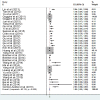Ambient temperature and cardiovascular mortality: a systematic review and meta-analysis
- PMID: 28791197
- PMCID: PMC5546177
- DOI: 10.7717/peerj.3574
Ambient temperature and cardiovascular mortality: a systematic review and meta-analysis
Abstract
Introduction: Our study aims at identifying and quantifying the relationship between the cold and heat exposure and the risk of cardiovascular mortality through a systematic review and meta-analysis.
Material and methods: A systematic review and meta-analysis were conducted based on the Preferred Reporting Items for Systematic Reviews and Meta-Analyses (PRISMA) guideline. Peer-reviewed studies about the temperature and cardiovascular mortality were retrieved in the MEDLINE, Web of Science, and Scopus databases from January 2000 up to the end of 2015. The pooled effect sizes of short-term effect were calculated for the heat exposure and cold exposure separately. Also, we assessed the dose-response relationship of temperature-cardiovascular mortality by a change in units of latitudes, longitude, lag days and annual mean temperature by meta-regression.
Result: After screening the titles, abstracts and full texts, a total of 26 articles were included in the meta-analysis. The risk of cardiovascular mortality increased by 5% (RR, 1.055; 95% CI [1.050-1.060]) for the cold exposure and 1.3% (RR, 1.013; 95% CI [1.011-1.015]) for the heat exposure. The short-term effects of cold and heat exposure on the risk of cardiovascular mortality in males were 3.8% (RR, 1.038; 95% CI [1.034-1.043]) and 1.1%( RR, 1.011; 95% CI [1.009-1.013]) respectively. Moreover, the effects of cold and heat exposure on risk of cardiovascular mortality in females were 4.1% (RR, 1.041; 95% CI [1.037-1.045]) and 1.4% (RR, 1.014; 95% CI [1.011-1.017]) respectively. In the elderly, it was at an 8.1% increase and a 6% increase in the heat and cold exposure, respectively. The greatest risk of cardiovascular mortality in cold temperature was in the 14 lag days (RR, 1.09; 95% CI [1.07-1.010]) and in hot temperatures in the seven lag days (RR, 1.14; 95% CI [1.09-1.17]). The significant dose-response relationship of latitude and longitude in cold exposure with cardiovascular mortality was found. The results showed that the risk of cardiovascular mortality increased with each degree increased significantly in latitude and longitude in cold exposure (0.2%, 95% CI [0.006-0.035]) and (0.07%, 95% CI [0.0003-0.014]) respectively. The risk of cardiovascular mortality increased with each degree increase in latitude in heat exposure (0.07%, 95% CI [0.0008-0.124]).
Conclusion: Our findings indicate that the increase and decrease in ambient temperature had a relationship with the cardiovascular mortality. To prevent the temperature- related mortality, persons with cardiovascular disease and the elderly should be targeted. The review has been registered with PROSPERO (registration number CRD42016037673).
Keywords: Ambient temperature; Cardiovascular mortality; Cold exposure; Heat exposure; Meteorological variables.
Conflict of interest statement
The authors declare there are no competing interests.
Figures









References
-
- Ahmadnezhad E, Holakouie Naieni K, Ardalan A, Mahmoodi M, Yunesian M, Naddafi K, Mesdaghinia AR. Excess mortality during heat waves, Tehran Iran: an ecological time-series study. Journal of Research in Health Sciences. 2013;13:24–31. - PubMed
-
- Bai L, Woodward A, Liu Q. Temperature and mortality on the roof of the world: a time-series analysis in three Tibetan counties, China. Science of the Total Environment. 2014;485:41–48. - PubMed
LinkOut - more resources
Full Text Sources
Other Literature Sources

